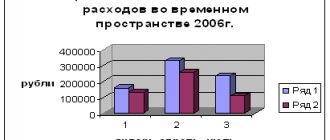The role and basis for the formation of accounting policies in accounting
All organizations, both large and small, are required to have an Accounting Policy drawn up in accordance with the law. Due to various changes, this is especially important for any business in 2020
Determination of accounting policies
Therefore, we can say that accounting policy is one of the most important components of any enterprise.
The procedure for developing the organization’s accounting policy for 2020 was approved by Order of the Ministry of Finance of Russia dated October 6, 2008 N 106n “On approval of accounting regulations”, the corresponding provision “Accounting Policy of the Organization” (PBU 1/2008).”
The general provisions have not changed much compared to 2021 and 2021. As before, all organizations are required to formulate accounting policies. But if earlier this responsibility was the chief accountant's, now this can be assigned to any person in the enterprise who maintains accounting records.
Accounting for income and expenses
What follows is a large block of questions related to accounting for the organization’s income and expenses. The first and most significant issue in this block is the method of recognizing income and expenses. Only organizations whose average revenue from the sale of goods (work, services) excluding VAT over the previous four quarters did not exceed 1 million rubles for each quarter can afford to freely choose one of the two methods. That is, those who have the right to use the cash method, but want to use the accrual method. Other organizations are required to indicate the “accrual method” in their accounting policies on a non-alternative basis. The accounting policy of the organization for tax purposes does not reflect other features of accounting; there is a separate document for this.
The next question concerns only enterprises with a long technological cycle (production, the start and end dates of which fall on different tax periods, regardless of the number of days of production), for which stage-by-stage delivery of work (services) is not provided. Such organizations have the right to establish in their accounting policies the procedure for recognizing income by distributing it between reporting periods either in equal shares based on the number of periods, or in proportion to the costs incurred, or in another reasonable way. The choice of one of the options depends on the principles of tax planning determined by the organization independently.
Next, the point related to the procedure for recognizing losses from the assignment of the right to claim a debt before the maturity date is revealed. The indicator on the basis of which the normalization of the amount of loss is calculated is calculated at the choice of the organization:
- based on the maximum interest rate established by type of currency;
- based on rates on debt obligations confirmed by the methods provided for in paragraph 1 of Article 105.7 of the Tax Code of the Russian Federation (methods used in determining for tax purposes profit in transactions to which the parties are interdependent persons).
If an organization uses the comparable market prices method for these purposes, then it needs to establish comparability criteria (for example, the same currency, the same period, another similar indicator at the discretion of the organization).
For R&D expenses, an organization needs to specify how these expenses will be accounted for. There are two options:
- These expenses will form the cost of intangible assets (in this case, inclusion in expenses is made through depreciation over a certain useful life).
- As part of other expenses (in this case, inclusion in expenses is carried out within two years).
An organization has the right to apply a coefficient of 1.5 to actual R&D expenses for the purpose of including them in expenses that reduce the taxable base for income tax. An appropriate indication of this fact should be made in the accounting policy. It must be remembered that if an organization chooses to use this coefficient, it is additionally charged with the obligation to provide to the tax authority at its location a report on R&D performed, the costs of which are recognized in the amount of actual costs using a coefficient of 1.5. The report is submitted to the tax authority simultaneously with the tax return based on the results of the tax period in which the relevant R&D was completed. A progress report is provided for each R&D project.
The next question concerns the accounting treatment of rental income. At the choice of the organization, they are taken into account either as part of sales income or as part of non-operating income. The choice of option depends on how the specified income was recognized in accounting.
What should the accounting policy contain in 2021?
The following items must be approved in the accounting policy:
— working chart of accounts of the enterprise;
— forms of primary documents and other registers;
— the procedure for conducting inventory;
— methods for assessing liabilities and assets;
— control over business operations.
The organization also has the right to introduce other items that are important to it.
Elements of accounting policies
[flat_ab id=”11"]
All newly appeared changes must be made to the Accounting Policy no later than December 31, 2021 , independently or using the special “Consultant Plus” program.
The accounting policy comes into force on January 1, 2020 . A newly formed organization must develop and approve its policies within 90 days of being registered.
If the parent organization has subsidiaries and other divisions, then it must use its own accounting policies for all. for each separate division!!!
An enterprise has the right to change its accounting policies if new methods of accounting have been found, if legislation has undergone changes, as well as a reorganization of the enterprise or a change in the type of activity.
The new accounting policy begins to apply in the year following the reporting year, but by law it can also be applied in the current year 2021 under certain conditions.
What to include in accounting policies for accounting purposes
A universal accounting policy cannot be found even on the Internet. Its preparation depends entirely on the specific organization. To do this, take into account all the operations that the company has carried out in the past and plans to do in the future. Let's briefly go over the points that are important for accounting policies.
- Maintaining accounting manually or using a special program. You can also consider outsourcing your accounting.
- Purchase of materials using only account 10 “Materials” or using accounts 15 “Procurement and acquisition of material assets” and 16 “Deviation in the cost of material assets.” Accounts 15 and 16 help to keep actual records of the costs of procuring materials and determine the deviation from accounting prices, but they complicate accounting.
- Choosing a method for evaluating materials released into production. In accounting, three methods are allowed: by average cost, by the cost of each unit, by the FIFO method (by the cost of the first purchases).
- Choosing a method for calculating depreciation. There are four methods to choose from: linear, reducing balance, by the sum of the numbers of years of useful use, in proportion to the volume of work. The choice depends on the availability of a professional accountant and your personal skills. The simplest option is linear; it involves even accrual of depreciation over the useful life. All other methods are accelerated - in the first years the amount of depreciation exceeds the amount in subsequent years. If the calculation of depreciation in accounting differs from tax accounting, then differences will arise that will form tax liabilities and assets. In this case, you need a professional chief accountant.
- Account for assets worth up to 40,000 rubles as part of fixed assets or inventories.
- Establishment of useful life for intangible assets. The choice between the validity period of the rights to intangible assets and the period during which it is planned to receive benefits from the use of intangible assets.
- Selecting a method for calculating depreciation on intangible assets. These are the same methods as with assets, except for accrual in proportion to the volume of work performed. It is not available for IMAs.
- Selecting the cost at which goods released for sale will be written off. At the cost of each unit, at average or FIFO.
- Choosing a method for accounting for the costs of procuring and transporting goods to the warehouse. Such expenses can be included in selling expenses or directly charged to cost.
- Selecting the distribution of costs on account 26 “General business expenses”. The first option is that costs are written off proportionally to accounts 20 “Main production”, 23 “Auxiliary production”, 29 “Production and household maintenance”. The second option is to write it off directly to account 90 “Product sales”.
Keep records of exports and imports in the Kontur.Accounting web service. Simple accounting, payroll and reporting in one service
These are not all the points that are reflected in the accounting policy. If you do not have accounting knowledge, turn to professionals or work in an accounting service where an accounting policy has already been developed - for example, in Kontur.Accounting. In addition, the policy must have a working chart of accounts and forms of primary documents. For a complete list of provisions that must be reflected in the accounting policies, see PBU 1/2008.
A working chart of accounts is a list of accounts that a company uses. Based on the accounting chart of accounts, from which unnecessary items are excluded. For example, account 11 “Animals for fattening” will not appear in the working chart of accounts of an oil company. Although the situations are different, it may be that the company breeds pigs at the same time. As already said, it all depends on the specific organization.
Accounting policy 2021 - sample
1. Accounting policy (common template for all enterprises)
2. Accounting policies of a trading organization
3. Accounting policy of the management company
4. Accounting policy of an agricultural enterprise
5. Accounting policy for tax accounting purposes
5.
[f[flat_ab id=»5"]p>
What happens if I haven’t drawn up an accounting policy?
At first, you are in no danger. There are no fines for this. But when checking, the Federal Tax Service has the right to request your UE. A fine will be imposed for failure to provide it.
In addition, the tax office strictly checks your transactions for compliance with accounting policies. And if it is missing, then wait for additional charges.
To make your work easier and save time, consider the accounting web service Kontur.Accounting. It has already developed accounting policy options for different tax regimes and their combination. The program makes it easy and convenient to maintain accounting and tax records, pay taxes, salaries, and submit reports via the Internet. We give all newbies a free 14-day trial period.
Explanatory note and accounting policies of the organization
Organizations that publish their reports, in accordance with PBU 1/2008, must indicate the methods of accounting in an explanatory note . This note should contain the following information:
— methods of calculating depreciation
— methods for assessing inventories, goods, finished products
— methods of recognizing revenue from various types of activities.
If the enterprise has made any amendments to its accounting policies, then in the explanatory note it is obliged to indicate the reason for these changes, their content and reflection of the consequences, as well as the application of new regulations.
Also, the explanatory note must indicate estimated values, which, according to PBU 21/2008, include:
- the amount of valuation reserves that the enterprise has created
- useful life.
It can be noted that changes in PBU are moving accounting and tax accounting further and further away from each other, since the Tax Code of the Russian Federation strictly determines the formation of a reserve for doubtful debts and prohibits changing the useful life.
Income tax
The profit section in the accounting policy is filled out only by organizations that are payers of income tax. First, you need to indicate how information is generated for the purposes of calculating the taxable base for income tax:
- by filling out specially designed tax accounting registers;
- by filling out accounting registers, supplemented, if necessary, with relevant details.
The choice of one of the options depends on the organization itself, taking into account how its accounting procedures are organized and document flow is structured.
Next, the organization must indicate which reporting period it applies for income tax - monthly or quarterly. The choice depends solely on the organization itself and its desire to generate income tax indicators in one way or another.
Tax accounting policies should reflect the payment of monthly advance payments. There are no choice options, since those who are exempt from making advance payments of income tax are directly named in paragraph 3 of Article 286 of the Tax Code of the Russian Federation. This moment is purely ascertaining in nature.
Organizations that have separate structural divisions located on the territory of different subjects of the Federation must disclose in their accounting policies information about the basic indicator in proportion to which (in addition to the residual value of depreciable property) the share of profit attributable to the separate division is distributed. The organization chooses either a share of the average number of employees of the department, or a share of the costs of paying for their labor. The choice of one of the options depends solely on the organization itself, depending on the professional judgment of its officials.
Organizational aspects of accounting policies
Information about the reporting year should be reflected here primarily. For all organizations this is the period from January 1 to December 31.
Organizational order of the accounting service. The company establishes this procedure independently.
If the company’s accounting is kept by the chief accountant or an authorized person, then it is this person who is responsible for organizing accounting and maintaining accounting policies.
Mostly, organizations do not take the formation of a chart of accounts seriously, which subsequently leads to serious problems.
If necessary, the company can change the chart of accounts, as well as include or, conversely, remove subaccounts.
By law, organizations must use primary documents, the forms of which are provided in the albums of unified forms of primary accounting documentation, the development of which requires the availability of the following data:
- Title of the document
- form code
- Date of preparation
- name of the organization that compiled the document
- content of business transactions
- meters of business transactions in monetary and natural meters
- list of officials
- signatures of the parties.
Note. Today it is allowed to create your own forms of primary documents!!!
Also, the organization must approve the accounting registers that are necessary to accumulate information reflected in the primary documents for accounting.
The responsibility to ensure that the registers are compiled correctly lies with the person who compiled and signed them. These persons are required to keep state and commercial secrets.
The document flow schedule is also provided for in the accounting policy. The responsibility for its preparation lies with the chief accountant.
In accordance with clause 33 of the Accounting Regulations, reporting must include performance indicators of branches and divisions of this organization. But the law does not provide for the forms and deadlines for submitting reports of separate divisions, so this must be indicated in the accounting policies of the parent organization.
Among other things, the accounting policy prescribes the methods of reporting. The organization itself chooses how to submit reports to it: electronically or on paper.
Read also: Characteristics of the accounting policy of a trading enterprise
Organizational provisions
- For the purpose of generating information on tax accounting, the company discloses within the specified section data that allows it to more accurately generate the necessary information both in general and for each of the taxes for which it is a payer.
- Information about whether the company is newly created or not is necessary to establish whether the tax accounting policy of the organization is completely new or represents a modification of the old one. We note that the accounting policy is formed no later than 90 days from the date of establishment of the company and is applied consistently from year to year.
- Next, the company must indicate the types of business activities it carries out. This information, in addition to stating a fact, carries an additional burden. Depending on the specific type of activity, the organization forms the features of its accounting tax policy (primarily in terms of income tax).
- For the same purposes - to characterize the characteristics of the company’s activities, taken into account when generating data on tax accounting for income tax - the organization must indicate information about whether it carries out transactions with securities and whether it incurs R&D expenses in the course of its activities.
- For the purpose of generating information on the procedure for maintaining property tax records, an organization must indicate whether it has property subject to taxation on its balance sheet.
- For structural characteristics, it is necessary to indicate in the accounting policy the presence (absence) of separate structural divisions, including those located on the territory of one subject of the Federation.
- What follows is a block of questions, the answers to which characterize the procedure for organizing tax accounting. The company has the right to keep records of data both with the involvement of a third-party organization or a specially authorized person (in this case, their name should be indicated in the text of the accounting policy), and on its own. If tax accounting is carried out in-house, then it is necessary to indicate who is doing this - an individual employee or a specialized service. In both cases, specification is required, that is, an exact indication of the employee’s position according to the staffing table or the name of the department in accordance with the company structure.
- An essential point is to indicate the method of tax accounting (automated or non-automated). When choosing an automated method, you must additionally specify the specialized program with which tax accounting is maintained.
Cash storage limit at the cash desk
Clause 2 of the “Procedure for conducting cash transactions by legal entities and the simplified procedure for conducting cash transactions by individual entrepreneurs and small businesses”, approved by Directive of the Bank of Russia dated March 11, 2014 No. 3210-U, stipulates that legal entities must independently determine the limit of cash that can kept in the organization's cash register. Of course, the limit itself should not be indicated in the organization’s accounting policy. Simply because it has nothing to do directly with accounting. And most organizations have no choice in this matter - the Central Bank ordered it, which means there must be a limit.
Since the “majority” was mentioned, does it mean that a minority exists? Of course, where would we be without him? Many regulatory documents written “for everyone” necessarily indicate a certain category that may not do something that is required of the rest. In PBU, this category includes accounting “simplified” ones that are not subject to mandatory audit, taking the place where “small businesses” previously proudly sat. But in the Directive of the Bank of Russia such a replacement did not occur. And therefore, small enterprises and individual entrepreneurs retained the right not to determine the cash limit at the cash desk (see paragraph 10 of paragraph 2 of Bank of Russia Directive No. 3210-U). And it’s worth writing about this in the accounting policy. One of two things – either “we don’t use it because we have the right,” or “we use it because we want to.” The size of the limit, I repeat, does not need to be indicated in the text of the accounting policy. It will still be reviewed periodically. Shouldn’t we issue an order to make changes to the accounting policy every time the limit is changed?







